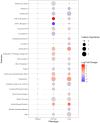Moving towards the detection of frailty with biomarkers: A population health study
- PMID: 38066663
- PMCID: PMC10861189
- DOI: 10.1111/acel.14030
Moving towards the detection of frailty with biomarkers: A population health study
Abstract
Aging adults experience increased health vulnerability and compromised abilities to cope with stressors, which are the clinical manifestations of frailty. Frailty is complex, and efforts to identify biomarkers to detect frailty and pre-frailty in the clinical setting are rarely reproduced across cohorts. We developed a predictive model incorporating biological and clinical frailty measures to identify robust biomarkers across data sets. Data were from two large cohorts of older adults: "Invecchiare in Chianti (Aging in Chianti, InCHIANTI Study") (n = 1453) from two small towns in Tuscany, Italy, and replicated in the Atherosclerosis Risk in Communities Study (ARIC) (n = 6508) from four U.S. communities. A complex systems approach to biomarker selection with a tree-boosting machine learning (ML) technique for supervised learning analysis was used to examine biomarker population differences across both datasets. Our approach compared predictors with robust, pre-frail, and frail participants and examined the ability to detect frailty status by race. Unique biomarker features identified in the InCHIANTI study allowed us to predict frailty with a model accuracy of 0.72 (95% confidence interval (CI) 0.66-0.80). Replication models in ARIC maintained a model accuracy of 0.64 (95% CI 0.66-0.72). Frail and pre-frail Black participant models maintained a lower model accuracy. The predictive panel of biomarkers identified in this study may improve the ability to detect frailty as a complex aging syndrome in the clinical setting. We propose several concrete next steps to keep research moving toward detecting frailty with biomarker-based detection methods.
Keywords: biomarkers; frailty; machine learning.
© 2023 The Authors. Aging Cell published by John Wiley & Sons Ltd and Anatomical Society. This article has been contributed to by U.S. Government employees and their work is in the public domain in the USA.
Conflict of interest statement
L.F. serves on the editorial board of Aging Cell. There are no other conflicts of interest to declare.
Figures




References
-
- Ah, Y. M. , Suh, Y. , Jun, K. , Hwang, S. , & Lee, J. Y. (2019). Effect of anticholinergic burden on treatment modification, delirium and mortality in newly diagnosed dementia patients starting a cholinesterase inhibitor: A population‐based study. Basic and Clinical Pharmacology and Toxicology, 124(6), 741–748. 10.1111/bcpt.13184 - DOI - PubMed
-
- Anon . (2015). World Health Organization. World Report on Ageing and Health. World Health Organization.
-
- Arts, M. H. L. , Collard, R. M. , Comijs, H. C. , Naudé, P. J. W. , Risselada, R. , Naarding, P. , & Oude Voshaar, R. C. (2015). Relationship between physical frailty and low‐grade inflammation in late‐life depression. Journal of the American Geriatrics Society, 63(8), 1652–1657. 10.1111/JGS.13528 - DOI - PubMed
-
- Barbato, A. , Russo, P. , Siani, A. , Folkerd, E. J. , Miller, M. A. , Venezia, A. , Grimaldi, C. , Strazzullo, P. , & Cappuccio, F. P. (2004). Aldosterone synthase gene (CYP11B2) C‐344T polymorphism, plasma aldosterone, renin activity and blood pressure in a multi‐ethnic population. Journal of Hypertension, 22(10), 1895–1901. 10.1097/00004872-200410000-00011 - DOI - PubMed
-
- Bergman, H. , Ferrucci, L. , Guralnik, J. , Hogan, D. B. , Hummel, S. , Karunananthan, S. , & Wolfson, C. (2007). Frailty: An emerging research and clinical paradigm–issues and controversies. The Journals of Gerontology. Series A, Biological Sciences and Medical Sciences, 62(7), 731–737. - PMC - PubMed
Publication types
MeSH terms
Substances
Grants and funding
LinkOut - more resources
Full Text Sources

